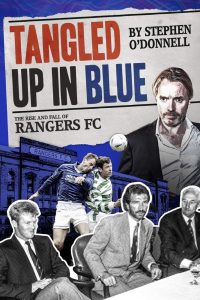Book Review – Divided Cities: The World’s Most Passionate Single City Derbies by Kevin Pogorzelski
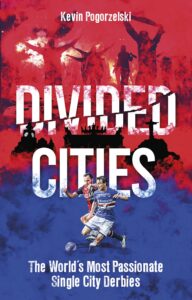 When the football fixtures are published each season, most supporters look for three keys things, firstly, their opening day fixture, secondly the last game of the campaign and of course their ‘derby’ fixtures. This idea of a ‘derby’ can mean different things to different clubs. This maybe because there is not another professional club in a particular city or town, or that even if there is, the teams have rarely crossed paths given they have historically played in different divisions.
When the football fixtures are published each season, most supporters look for three keys things, firstly, their opening day fixture, secondly the last game of the campaign and of course their ‘derby’ fixtures. This idea of a ‘derby’ can mean different things to different clubs. This maybe because there is not another professional club in a particular city or town, or that even if there is, the teams have rarely crossed paths given they have historically played in different divisions.
Kevin Pogorzelski in Divided Cities focuses on eleven single city derbies, with all but two (the Old Firm and Merseyside version) from outside the United Kingdom. As a Liverpool fan, with a regular diet of Premier League football and virtually the same old teams season-in season-out, Pogorzelski yearned for something more and in the books Introduction outlines the premise behind it.
“I became convinced that there was something unmatched about rivalries within the same city, where the people and place live the conflicts daily, which stems from a variety of diverse differences.”
In the table below is a summary of the games he attended which all have a dedicated chapter:
| Name | Translation | Teams | Location | Notes |
| Derby della Lanterna | Derby of the Lantern | Genoa & Sampdoria | Genoa | The Torre della Lanterna is the ancient landmark and the main lighthouse for the city’s port. |
| Derby della Capitale | Derby of the Capital | Lazio & Roma | Rome | Rome is the Italian capital. |
| Derbi da Segunda Circular | See Notes | Benfica & Sporting Lisbon | Lisbon | The Segunda Circular is the road that separates the two stadiums. |
| The Old Firm Derby | N/A | Celtic & Rangers | Glasgow | Origin unclear. May derive from the two clubs’ initial match in which the commentators referred to the teams as “like two old, firm friends” or alternatively may stem from a satirical cartoon published in ‘The Scottish Referee’ sports newspaper prior to the 1904 Scottish Cup Final between the sides, depicting an elderly man with a sandwich board reading “Patronise The Old Firm: Rangers, Celtic Ltd” highlighting the mutual commercial benefits of their meetings. |
| The Budapest Derby | N/A | Ferencvaros & Ujpest | Budapest | Budapest is the capital of Hungary. |
| Clasico das Multidoes | Classic of the Crowds | Flamengo & Fluminense | Rio de Janeiro | Known also as Fla-Flu Derby. |
| Intercontinental Derby | See Notes. | Fenerbahce & Galatasaray | Istanbul | Fenerbahce and Galatasaray are two of the major Turkish teams from the Asian and the European parts of Istanbul respectively. |
| Superclasico | Super Derby | Boca Juniors & River Plate | Buenos Aires | From the Spanish usage of “clasico” to mean derby, with the prefix “super” used as the two clubs are the most popular and successful clubs in Argentine football. |
| The Eternal Derby | N/A | Crvena Zvezda & Partizan Belgrade | Belgrade | Thought to be from the phrase ‘Eternal Enemies’. |
| El Gran Derbi | The Grand Derby | Real Betis & Seville | Seville | Possibly due to the ‘biggest and grandest’ intensity on and off the pitch of the rivalry. |
| Merseyside Derby | N/A | Everton & Liverpool | Liverpool | Named after County that both clubs are within. |
Each chapter provides a basic history and background to the rivalry, but is as the author states, “to add context to the stories” rather than be a detailed account or indeed record of the games down the years. Pogorzelski aims to provide readers with a true reflection (or as close as possible as an ‘outsider’ can be at these games) to the matchday experience of the local fan and this does provide for some very interesting encounters with Ultra groups across his travels and most especially his experience as a Liverpool fan at the Merseyside derby amongst the Everton faithful, where there was no language barriers as to the abuse and vitriol being handed out.
Unfortunately down the years and still to this day, the rivalries can spill into violence and whilst Pogorzelski in no way glorifies these events, is able to put across the hostility that often lies and bubbles just beneath the surface at the games, without generally being caught out amongst it. And it poses an interesting question as to whether a ‘sanitized’ environment for these encounters would have the same appeal? In England the debate rages as to the lack of atmosphere created by all-seater stadium and indeed whether the increase of the ‘football tourist’ or ‘neutral’ fan going to games abroad impacts the authenticity for the locals and the clubs identity, in the case of clubs such as St Pauli or 1. FC Union Berlin.
To a certain extent this book is a Groundhopper’s dream, taking in some of the finest cities and fixtures from Europe and South America. However, what it highlights is that these trips require incredible planning and organisation in terms of travel, more often than not deep pockets to afford the trip including tickets and some luck or indeed significant contacts in order to obtain the necessary supporter/fan memberships and tickets.
For many this book will be nearest they get to enjoying these encounters, but Divided Cities is nevertheless successful in portraying to readers the intensity of the matchday experience and what it means to those that attend these passionate derbies.
(Publisher: Pitch Publishing Ltd. March 2023. Paperback: 320 pages)
Buy the book here: Divided Cities
 Compelling, entertaining and refreshingly honest, One in a Million is the autobiography of Trevor Francis, the subject of the first £1 million transfer fee in football history – a record for all time.
Compelling, entertaining and refreshingly honest, One in a Million is the autobiography of Trevor Francis, the subject of the first £1 million transfer fee in football history – a record for all time.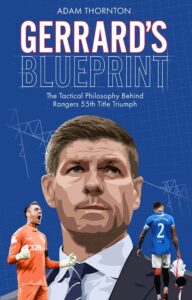 An in-depth analysis of Rangers’ tactical evolution over three seasons under Steven Gerrard, culminating in a league title win which saw them crowned kings of Scotland for a 55th time.
An in-depth analysis of Rangers’ tactical evolution over three seasons under Steven Gerrard, culminating in a league title win which saw them crowned kings of Scotland for a 55th time.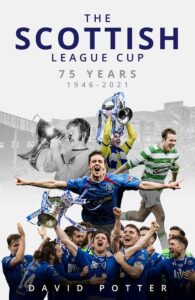 The Scottish League Cup is often wrongly described as the ‘Cinderella’ of Scottish football, as distinct from its two ugly sisters, the Scottish League and the Scottish Cup.
The Scottish League Cup is often wrongly described as the ‘Cinderella’ of Scottish football, as distinct from its two ugly sisters, the Scottish League and the Scottish Cup.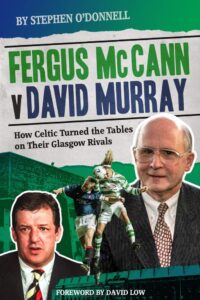 Fergus McCann Versus David Murray charts the changing fortunes of Glasgow’s two great footballing rivals as shaped by two business moguls. Both men came to prominence in the 1990s when new methods of governance and finance were taking hold of football.
Fergus McCann Versus David Murray charts the changing fortunes of Glasgow’s two great footballing rivals as shaped by two business moguls. Both men came to prominence in the 1990s when new methods of governance and finance were taking hold of football.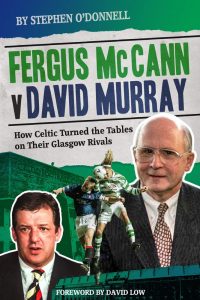 Stephen O’Donnell’s book is a thorough and powerful analysis of how the Glasgow footballing giants – Celtic and Rangers – have been managed and mismanaged. Two ex-Chairmen are the focus of the narrative and it is a damning commentary on how borrowing on a huge scale, mostly prompted by the self-promoting David Murray, was the eventual undoing of Rangers whilst Celtic found an unlikely hero in Fergus McCann. His ‘tight-ship’ budgeting proved unpopular at the time, especially when contrasted with free-spending Rangers, but ultimately proved to be the correct approach.
Stephen O’Donnell’s book is a thorough and powerful analysis of how the Glasgow footballing giants – Celtic and Rangers – have been managed and mismanaged. Two ex-Chairmen are the focus of the narrative and it is a damning commentary on how borrowing on a huge scale, mostly prompted by the self-promoting David Murray, was the eventual undoing of Rangers whilst Celtic found an unlikely hero in Fergus McCann. His ‘tight-ship’ budgeting proved unpopular at the time, especially when contrasted with free-spending Rangers, but ultimately proved to be the correct approach. For those young ‘uns brought up on the misleading title ‘Champions’ League’, it might come as a surprise to learn that the European Cup Winners’ Cup actually was a cup competition between European teams who had won their own domestic cup finals, not just another chance for the top clubs to keep on playing each other and guarantee income streams.
For those young ‘uns brought up on the misleading title ‘Champions’ League’, it might come as a surprise to learn that the European Cup Winners’ Cup actually was a cup competition between European teams who had won their own domestic cup finals, not just another chance for the top clubs to keep on playing each other and guarantee income streams.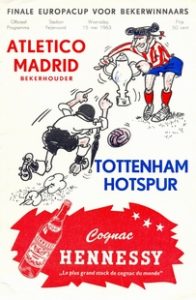 The most memorable of the early finals was Tottenham’s 5-1 thumping in 1963 of Atletico Madrid, winners the previous year. Two of the goals for Spurs were scored by the peerless Jimmy Greaves whose injury in the World Cup group stages probably cost him his place in the Final. No substitutes in those days, so a suited Greaves had to watch England’s historic win from the bench as a supporter. Spurs were the first British winners in Europe, and it was a fitting reward, and swansong, for a team who had done the domestic ‘double’ in 1961 – the first time by any club in 64 years.
The most memorable of the early finals was Tottenham’s 5-1 thumping in 1963 of Atletico Madrid, winners the previous year. Two of the goals for Spurs were scored by the peerless Jimmy Greaves whose injury in the World Cup group stages probably cost him his place in the Final. No substitutes in those days, so a suited Greaves had to watch England’s historic win from the bench as a supporter. Spurs were the first British winners in Europe, and it was a fitting reward, and swansong, for a team who had done the domestic ‘double’ in 1961 – the first time by any club in 64 years. The last match with strong links to the World Cup Final was, understandably enough, the Final in May 1966 where Liverpool lost 2-1 after extra time to Borussia Dortmund, a kind of England v West Germany rehearsal. Kind of. Roger Hunt would go on two months later to turn the tables on the three Dortmund players selected for their nation in the Final; Tilkowski, Emmerich and Held. Hunt is famous for doing absolutely nothing in the World Cup Final except turn away to celebrate Hurst’s ‘was it over the line’ goal.
The last match with strong links to the World Cup Final was, understandably enough, the Final in May 1966 where Liverpool lost 2-1 after extra time to Borussia Dortmund, a kind of England v West Germany rehearsal. Kind of. Roger Hunt would go on two months later to turn the tables on the three Dortmund players selected for their nation in the Final; Tilkowski, Emmerich and Held. Hunt is famous for doing absolutely nothing in the World Cup Final except turn away to celebrate Hurst’s ‘was it over the line’ goal. The European Cup Winners’ Cup (ECWC) competition came into being in the 1960/61 season, and as its title suggests qualification was attained by being the winners of a countries domestic cup. Despite its creation after the first European Cup competition in 1955/56 and the Inter-Cities Fairs Cup which also began in 1955 (before it morphed into the UEFA Cup in 1971/72) and therefore being the youngest of the three competitions, it was though seen as the next most prominent after the European Cup. It continued until the 1998/99 season with the final playing of the tournament between SS Lazio and RCD Mallorca at Villa Park, home of Aston Villa, the last of the 39 Finals.
The European Cup Winners’ Cup (ECWC) competition came into being in the 1960/61 season, and as its title suggests qualification was attained by being the winners of a countries domestic cup. Despite its creation after the first European Cup competition in 1955/56 and the Inter-Cities Fairs Cup which also began in 1955 (before it morphed into the UEFA Cup in 1971/72) and therefore being the youngest of the three competitions, it was though seen as the next most prominent after the European Cup. It continued until the 1998/99 season with the final playing of the tournament between SS Lazio and RCD Mallorca at Villa Park, home of Aston Villa, the last of the 39 Finals.